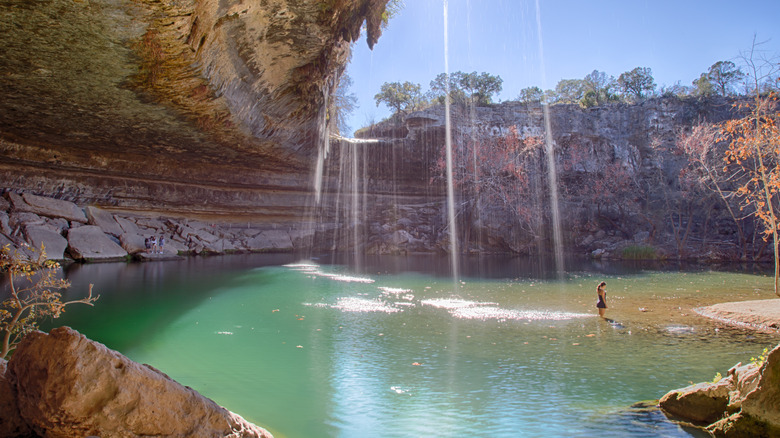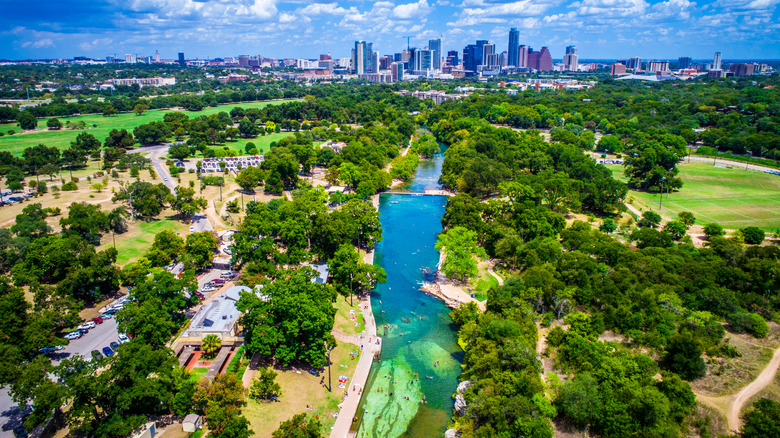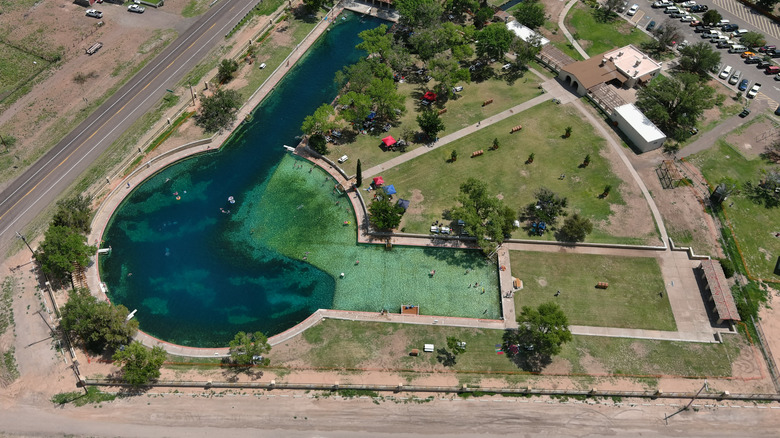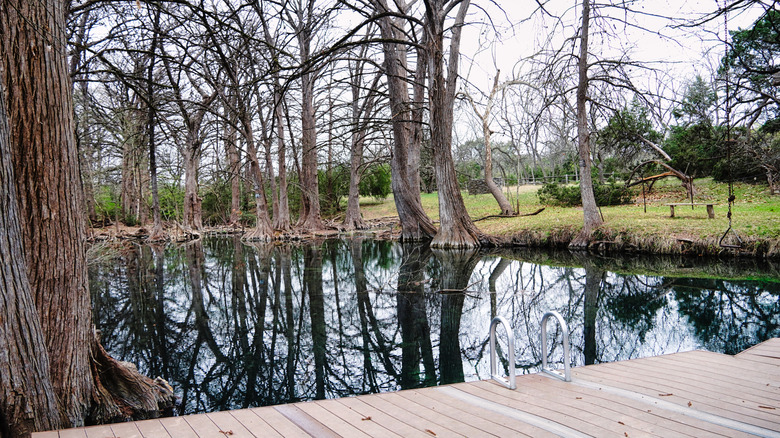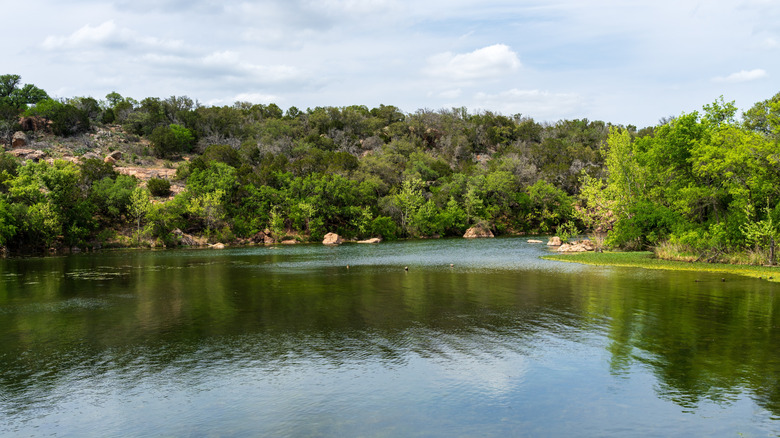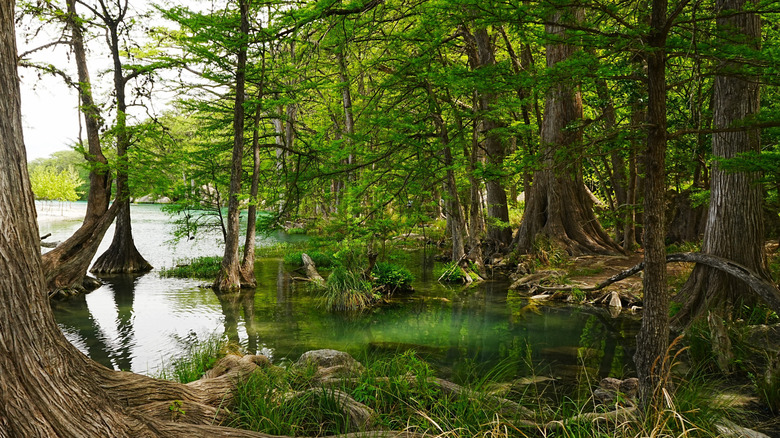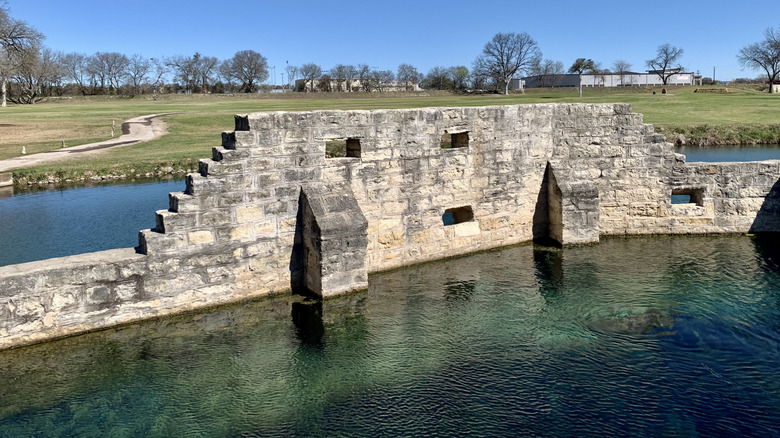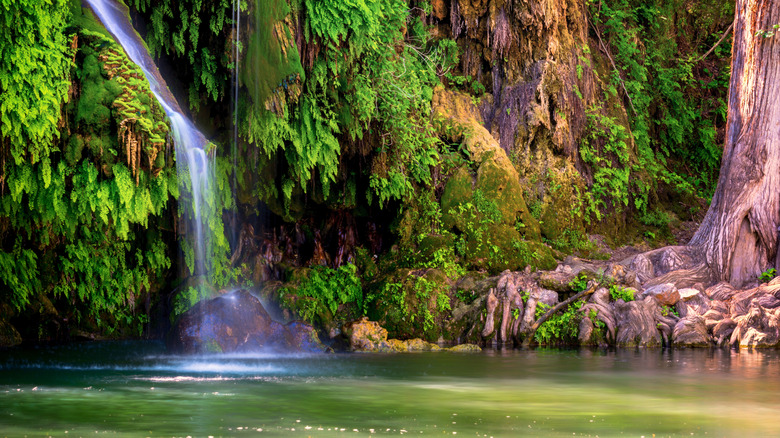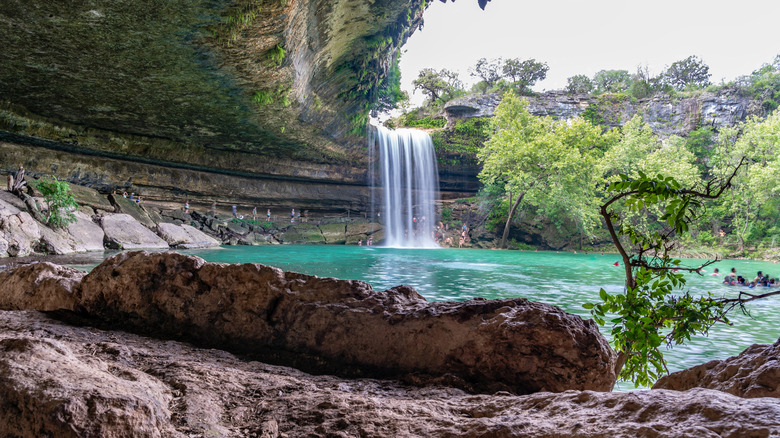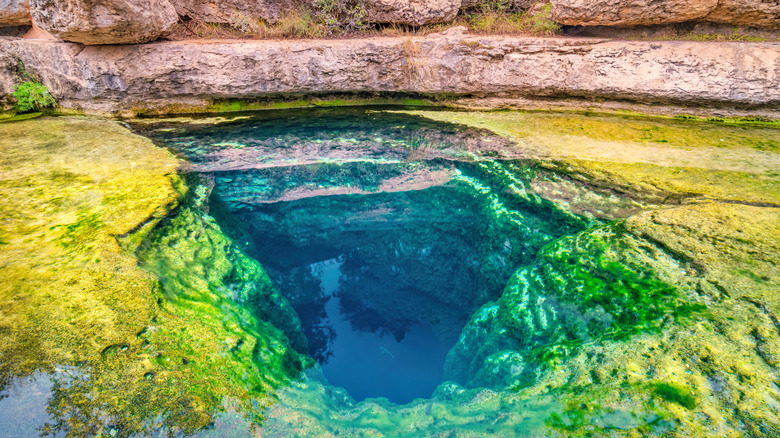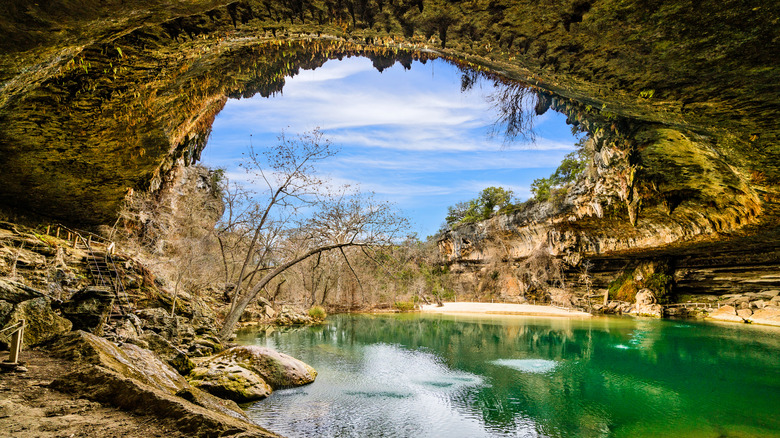9 Best Swimming Holes In Texas Offering A Refreshing Escape
If there's anything a Texan learns early, it's how to handle the heat. Luckily, the Lone Star State is dotted with natural swimming holes that aren't just places to cool off — though that's certainly not the biggest draw. Many of these spots are full adventures in their own right, with lots of places to chase the perfect summer dip. If you're looking for something scenic, refreshing, and maybe with a touch of historical interest to make the trip feel special, a Texas swimming hole is the perfect spot to find real Southern charm.
Each of the watering holes on this list offers its own little sprinkle of summertime magic. They include famous spots like the underwater caves of Jacob's Well, the collapsed grotto of Hamilton Pool, as well as some more relaxed, social spaces like Garner State Park or Hancock Springs, which is steeped in soothing nostalgia that has brought families back to visit generation after generation. One park protects an endangered salamander population, another features a long-beloved rope swing, and many offer onsite camping options to round out your stay. Something for everyone? You bet.
From weekend adventures to lazy, family-friendly floats to photo-worthy splashes with zero commitment to actually doing much swimming, these spots prove there's no wrong way to take a dip into Texas. We'll also add a few local finds, some seasonal tips, and a little travel-friendly advice for anyone ready to experience a Texas watering hole to its fullest.
For city dwellers: Barton Springs Pool, Austin
Right in the heart of Austin's Zilker Park, this spring-fed pool holds an average temperature around 68 to 70 degrees Fahrenheit year-round, meaning you can take a dip in January just as easily as July — though most locals stick to the summer. The water itself is crystal clear and naturally filtered. While it looks perfectly curated, it's a fully natural pool complete with aquatic vegetation and a few fish darting around. If you're lucky, you might spot the endangered Barton Springs salamander, which can only be found in Texas.
Barton Springs is also ideal for out-of-towners and city slickers who want to experience a bit of nature without straying too far from the convenience of Austin's best tacos and live music. Even better, Austin is one of America's best destinations for female solo travelers. If you're planning to visit, early spring or late fall are the sweet spots. Temperatures are still warm enough to swim, but the crowds thin out dramatically compared to July. Parking can be tricky, so taking the shuttle to Zilker Park or biking in from downtown are recommended alternatives. The pool is open year-round, every day of the week, but it is closed for cleaning on Thursday from 9 a.m. to 7 p.m. From mid-March to late October, day pass tickets are $4 to $9 per person, but admission is free for the rest of the year. No matter when you visit, though, Barton Springs never loses its magic.
For the best desert oasis: Balmorhea State Park
It's hard to imagine an oasis in the middle of the West Texas desert until you see Balmorhea with your own eyes. Located near the tiny town of Toyahvale, this massive spring-fed pool has been drawing travelers since the 1930s. Built by the Civilian Conservation Corps, Balmorhea is the world's largest spring-fed swimming pool, measureing 1.3 acres and holding more than 3.5 million gallons of water. The San Solomon Springs feed the pool constantly, keeping it between 72 and 76 degrees Fahrenheit year-round, which is just on the right side of refreshing when the desert sun starts to blaze. What makes Balmorhea special isn't just its size, but also what lies beneath the surface. You can snorkel or even scuba dive here to explore limestone formations and spot native fish, which the park takes care to preserve. Above ground, the scenery is equally eye-catching with bright turquoise water set against the desert's dusty hills.
When you've had your fill of swimming, nearby Fort Davis is always worth a visit. It has a charming main street and one of the best stargazing spots in the country at the McDonald Observatory. The best time to visit Balmorhea is late spring or early fall. The summer heat can be brutal, and the park occasionally closes for maintenance around then. Bring cash for the $7 entrance fee, pack a hat, and don't forget your snorkel. You won't find another swimming experience like this in the entire Southwest.
For families: Blue Hole Regional Park, Wimberley
If you picture the quintessential Texas swimming hole, one that's cool, shaded, and framed by towering cypress trees, you're picturing Blue Hole in Wimberley. The water here is a truly blue, glassy color that practically glows in the sun. Unlike some of the wilder swimming spots, Blue Hole feels accessible to newbies and is incredibly family-friendly with its calm water and clearly-defined swimming area that doesn't get too deep. There are also a few classic rope swings that will make you feel like a kid again.
Blue Hole is a local favorite, especially among families looking to escape the heat without roughing it. Reservations are required to swim (May through September only), and it's highly recommended to book ahead. The water stays refreshingly cool all summer thanks to the natural springs that feed it, and the surrounding trees offer plenty of shade — a welcome respite in the dead of July heat. If you'd like to make a weekend of it, Wimberley itself is a charming Hill Country town worth a few hours of exploring. Wimberley Square has some local eateries and shops that feel delightfully small-town Texas. Nearby cabin rentals are a great option for overnight stays, and the best time to go is around late May or early June, before the most intense heat and the biggest crowds hit. Bring your floats and a picnic basket. This is the perfect spot for a summer day out with the family.
For weekend adventurers: Inks Lake State Park's Devil's Water Hole
Tucked into the Highland Lakes region, Devil's Water Hole at Inks Lake State Park is one of those spots that feels like you're miles from civilization. The hidden beauty is that you can still grab coffee or sunscreen in town if you need to! The watering hole itself sits at the end of the park's lake and is surrounded by trails, waterfalls, and a gorgeous pink and gold canyon. You can swim, kayak, or climb up the rocks and jump straight in.
Inks Lake may seem like a secluded Texas state park, but there is so much to do nearby. You could easily fill an entire weekend hiking the Pecan Flats Trail, renting a paddleboat, or fishing for sunfish and bass. There are nearly 200 campsites and several cozy cabins right inside the park, which makes it perfect for a low-stress getaway. The nearby town of Burnet has just enough creature comforts to balance out your wilderness adventures. The best time to visit Devil's Water Hole is in March or April, when you'll get the added bonus of Texas wildflowers carpeting the surrounding hillsides. The park is only about an hour outside of Austin, so it's a super easy "get out of the city" escape. If you're planning to camp, definitely reserve your $7 day passes in advance, especially if you're aiming for a weekend. Pro tip: Bring water shoes. The rocks can get slick and a little toasty in the sun.
For campers: Garner State Park on the Frio River
Garner State Park is one of those rare places that manages to feel nostalgic even if it's your first visit. In the Texas Hill Country near Concan, it's a mix of everything. Swimming, tubing, hiking, camping, and a summer dance tradition that dates all the way back to the 1940s. The Frio River runs cool and clear through the park, lined with bald cypress trees that turn a gorgeous, burnt orange in fall. You can wade, float, or set up a hammock by the bank and do absolutely nothing all day for just an $8 per person day pass. The 10 connected hiking trails (all of varying degrees of difficulty) make this park's more adventurous offerings even more spectacular. Between recreation and relaxation, it's all too easy to tailor a trip to suit everyone.
Since Garner is one of America's best-ranked state parks, it comes as no surprise that it also offers over 300 campsites and cabins, plus equipment rentals for just about everything you could need. When the sun goes down, there's the Garner Jukebox Dance at the park pavilion, a beloved Texas tradition where families and couples gather to two-step to oldies under the stars. Lost Maples State Natural Area is also just a short drive away if you want to add a scenic hike to your weekend. Spring and fall are ideal for visiting, especially since summer can get very crowded, but that's also when the river's energy is at its peak.
For watering hole newbies: Hancock Springs Free Flow Pool, Lampasas
If you're curious about Texas swimming holes but not quite ready to leap off cliffs or dive into any fish-filled depths, Hancock Springs in Lampasas is your perfect intro. It's one of the oldest continuously-operated, spring-fed pools in the state, first established in the late 1800s. What makes it "free-flowing" is that the spring water constantly runs through, keeping it naturally clean and right around 72 degrees. Think of it as nature's own infinity pool with more history and fewer crowds.
The pool has a built-up structure, with concrete sides and a defined depth, so it feels a little more predictable than the wild rivers and creeks elsewhere in Central Texas. That makes it especially great for families with young swimmers or those who just want to dip their toes without worry. You'll find a calm, local vibe here, and the surrounding town of Lampasas, an underrated Texas city with a cute downtown has some hidden gems as well, including wineries and a historic town square.
The pool is open from Thursdays to Sundays and admission is very affordable at just $3.50 for adults and $2.50 for kids. Travelers coming from Austin or Waco have an easy hour-and-a-half drive. which makes Hancock Springs a perfect day trip. It might not have waterfalls or caves, but its old-fashioned charm and steady, clear water make for a relaxing float. What's not to love?
For a natural spa: Krause Springs
If Barton Springs is Austin's backyard pool, Krause Springs is its hidden retreat. This place is blessedly shaded and dotted with over 30 natural springs bubbling all across the property. Located in Spicewood, about 30 miles west of Austin, Krause Springs is privately owned but open to the public. There are both man-made and natural pools — many connected by small waterfalls — and all shaded by enormous cypress trees. The main swimming hole is shallower than many others on this list, making it perfect for lounging. The upper pool is spring-fed and feels more like a traditional pool with its built-in steps and plenty of room to spread out. Down below, the lower natural pool feels like stepping into another world. Think ferns, moss, and the soothing sound of trickling water.
Both tent and RV camping are available, and it's worth staying overnight to enjoy the springs at golden hour when the day-trippers have cleared out. Krause Springs is open from mid-February through the end of October, but spring and early summer are the best times to visit. Pricing starts at $6 for children's day passes and goes as high as $30 for photo shoot fees. Bring water shoes and cash (they don't take cards), and note that this is a first-come, first-served sort of spot for both entry and camping. Krause Springs feels more like a sanctuary than a swimming hole, ideal for anyone in need of a spa day.
For photo ops: Hamilton Pool Preserve
And if you're looking for a spectacle, even if you never plan to swim, Hamilton Pool Preserve near Dripping Springs — an up-and-coming city with lavish comforts — is worth the trip for the sheer beauty of it. A collapsed limestone grotto forming a perfect natural amphitheater, with a 50-foot waterfall spilling into an emerald pool below? It looks like something out of a travel magazine, yet it's only about 45 minutes from Austin. The short hike to the pool is part of the charm at just a half-mile each way, but the journey is steep enough to make you feel like you've earned that gorgeous view. Swimming isn't always allowed since water quality and rockfall risk dictate access. Still, even when it's off-limits, it's one of the most photogenic places in Central Texas. The shaded grotto, the sound of the waterfall, the way the light filters through the opening all make for an otherworldly experience.
Hamilton Pool requires advance reservations year-round, and those spots fill up quickly, especially on weekends. Fees range from $3 to $12 per person, but be sure to check beforehand. The best times to visit are spring and early summer, when the waterfall is most active and the crowds are still manageable. Bring water shoes for wading, and if you're staying nearby, the town of Dripping Springs has plenty to offer, including the Dripping Springs Distillery Tour, an ideal "cheers" to celebrate your Hamilton Pool adventure.
Bonus: Jacob's Well Natural Area
Jacob's Well in Wimberley isn't just a water hole; it's a portal into the depths of Texas geology. This spring plunges straight down into a network of underwater caves that have fascinated divers and scientists for decades. The visible opening is about 12 feet wide, but beneath the surface, it drops more than 100 feet into a series of caverns. Only trained divers have been allowed to explore the cave systems beneath, but even from above, the dazzling Texas water hole is eye-catching with its clear, cold water in hints of blue and green. Of course, it should be noted that Jacob's Well has not allowed actual swimming since 2022 because the water is too shallow, but the Jacob's Well Natural Area around it is still open for hiking and exploring. Despite all this, it's one of the most magical places in Texas to hike around.
The water sits at a brisk 68 degrees year-round and the pool is surrounded by limestone cliffs perfect for sunbathing. However, since you can't cool off in the water, it's best to go when the day is not too hot. It's not typically crowded, partly because reservations are required and are tightly managed to protect the fragile environment. There are no sprawling lawns or food vendors, so it's best paired with a day of exploring Wimberley's shops or wineries. If you're up for adventure, the surrounding hiking trails through Texas's stunning Hill Country are perfect for pack a picnic and make a day of it. Although you can't swim, you can still get pictures of the gorgeous, blue water and, of course, plenty of memories. For anyone who loves geology, photography, or even a little thrill, Jacob's Well offers something totally unique.
Methodology
The methodology for this list involved researching each spot using primarily state park guides and travel sites, alongside visitor reviews for a few additional insights and personal context about what makes each place special. Every swimming hole considered for inclusion had to have a naturally fed water source, a scenic location, a reasonable degree of accessibility for a range of people with varying degrees of physical ability, and reliable operating hours during peak times of the year, mostly during the summer. Geological quirks, historical backstories, travel from major cities, and overall travel value all weighed in as well. While elements of distinct natural beauty were taken into account, the focus here is on variety and access. These are places all Texans and travelers alike can be comfortable and find plenty to do on a long weekend trip.
Think of this list as a choose-your-own-adventure map for the next time the Texas sun gets the better of you. Locals trying to rediscover their own backyard or out-of-staters looking for the kind of swimming hole that sticks in the memory long after the tan fades, everyone has something to appreciate here. All of these spots prove there's nothing boring about keeping cool in the Lone Star State.
